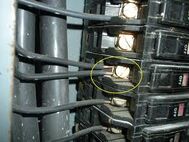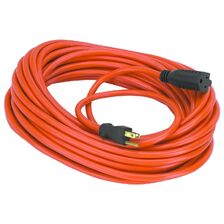Nity (Message Wall | contribs) No edit summary |
No edit summary Tag: apiedit |
||
| Line 4: | Line 4: | ||
<p style="background-position:initialinitial;background-repeat:initialinitial;"><span style="font-family:Arial; color:black">Following are ten of the most common electric panel and wiring defects that I find in inspections. </span></p> |
<p style="background-position:initialinitial;background-repeat:initialinitial;"><span style="font-family:Arial; color:black">Following are ten of the most common electric panel and wiring defects that I find in inspections. </span></p> |
||
| − | |||
| − | |||
| − | |||
==Over-fusing== |
==Over-fusing== |
||
Latest revision as of 07:14, 14 June 2017
Many electrical defects are difficult to understand. An amateur electrician only judges the work on whether electricity is supplied. He neglects to take the time to do the job correctly. Deciding if electrical work is correct is more than "does the light or socket work?" Approved electrical work is based on safety. The rules and regulations are designed to prevent fire and loss of life.
Following are ten of the most common electric panel and wiring defects that I find in inspections.
Over-fusing[]
Over-fusing occurs when the wire size does not match the breaker size. The breakers are designed to allow the flow of a
Double Lugging[]
Double lugging is connecting two wires to one breaker where there should be only one wire.
Missing 240 Volt Couplers[]
Joining two opposite 120-volt circuits creates a 240-volt circuit. Couplers ensure that if one side of the breaker trips, the other side trips also. Without the coupler, one side can trip while the other remains energized. Damage can occur.
Neutral and Ground Contact at Sub Panel[]
Neutral wires and the wire to ground must be separated in a sub panel. The neutral bar must be insulated with plastic to prevent contact with any metal parts.
More then Six Breakers with No Main Shut Off[]
A main shut-off is required in all main panels with more than six breakers. The main shut-off allows a person to shut off all power with one switch. If someone adds a few circuit breakers to an older panel, the added breakers may exceed the shut-off requirement. The main shut-off, or disconnect is a safety requirement. In case of an emergency, seconds count. The ability to shut off all circuits at once becomes important.
Improper Ground System[]
A "ground" is the side of an electric circuit connected to earth. A metal water pipe, Ufer bar, or ground "rod" provides electricity with a path to ground, or earth. If the path to ground is interrupted (by plastic pipe or loose clamps, for example), an electrical hazard can be the result.
Exposed Splices[]
When electric wires are joined, they should be in an approved electric junction box with cover. If wires become loose, electricity short circuits and can cause a fire. When splices are contained in a box, a fire is less likely to happen.
Charred Connections[]
This is a red flag. Evaluation must be done to determine why a wire has burned.
Extension Courts Used for Permenent Wiring[]
An extension cord over six feet long is not an approved wiring technique. Extension cords are light duty and susceptible to
Unprotected Wires[]
Wires mounted on a wall should be protected either with conduit, or should be installed behind wall surfaces.